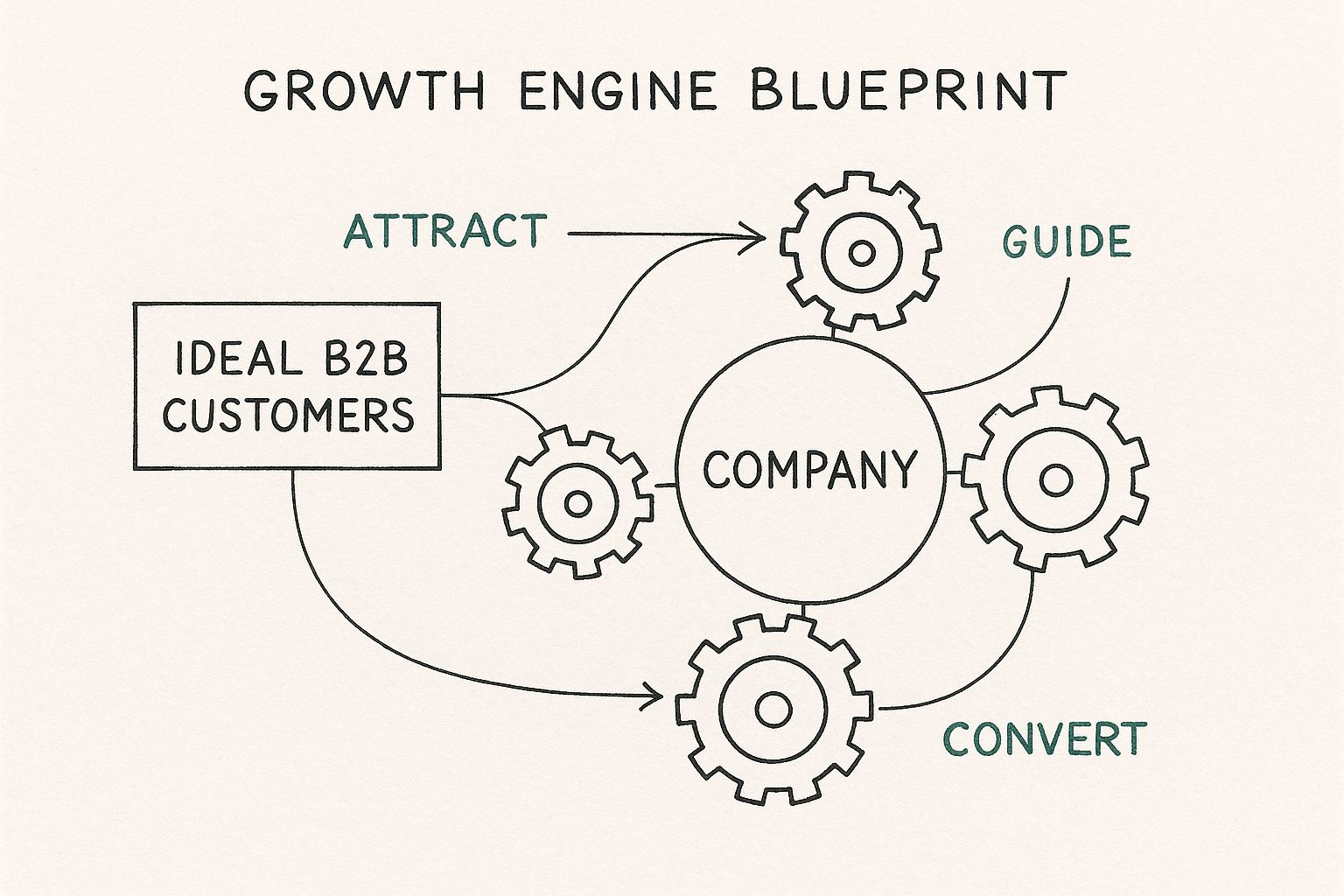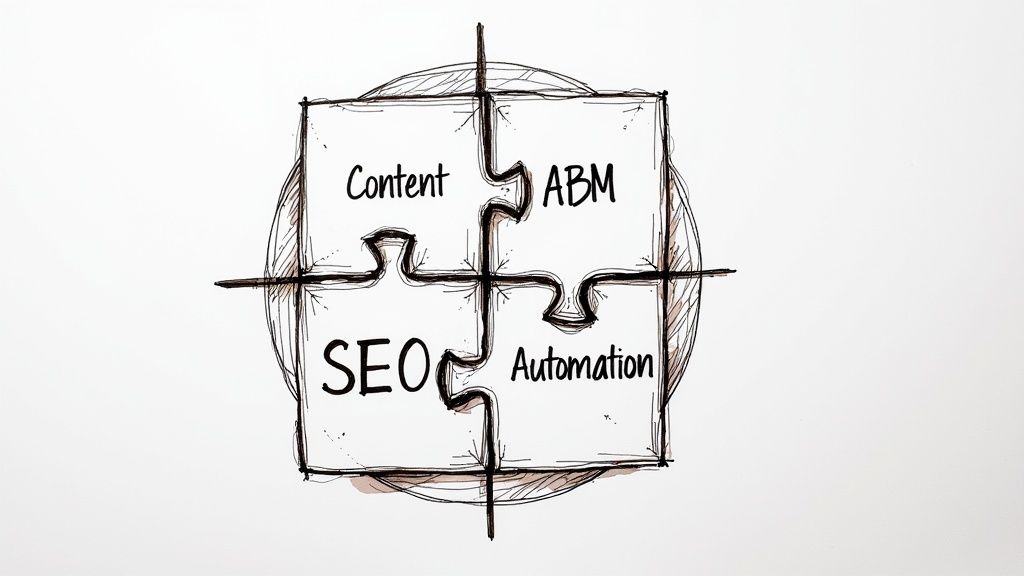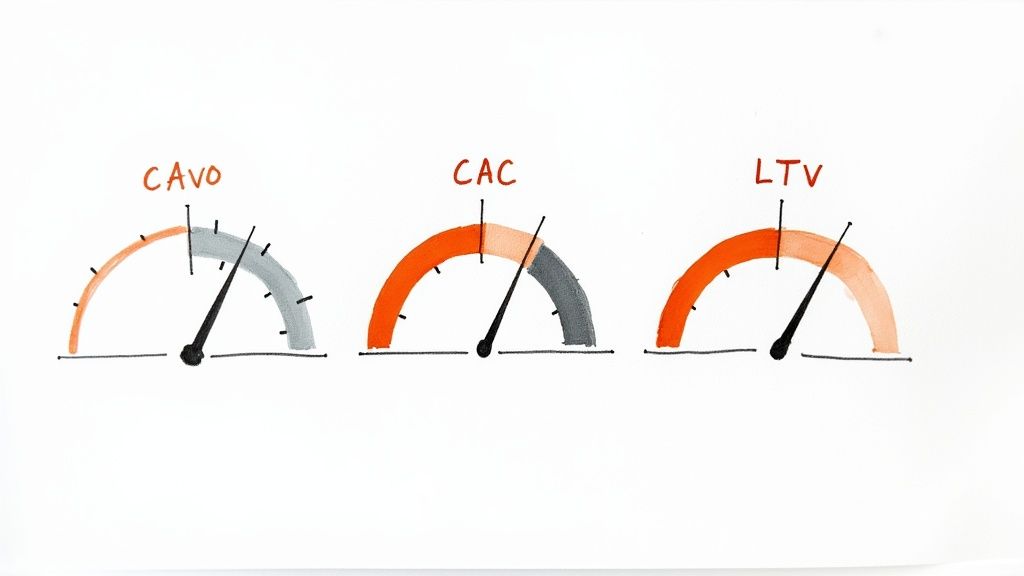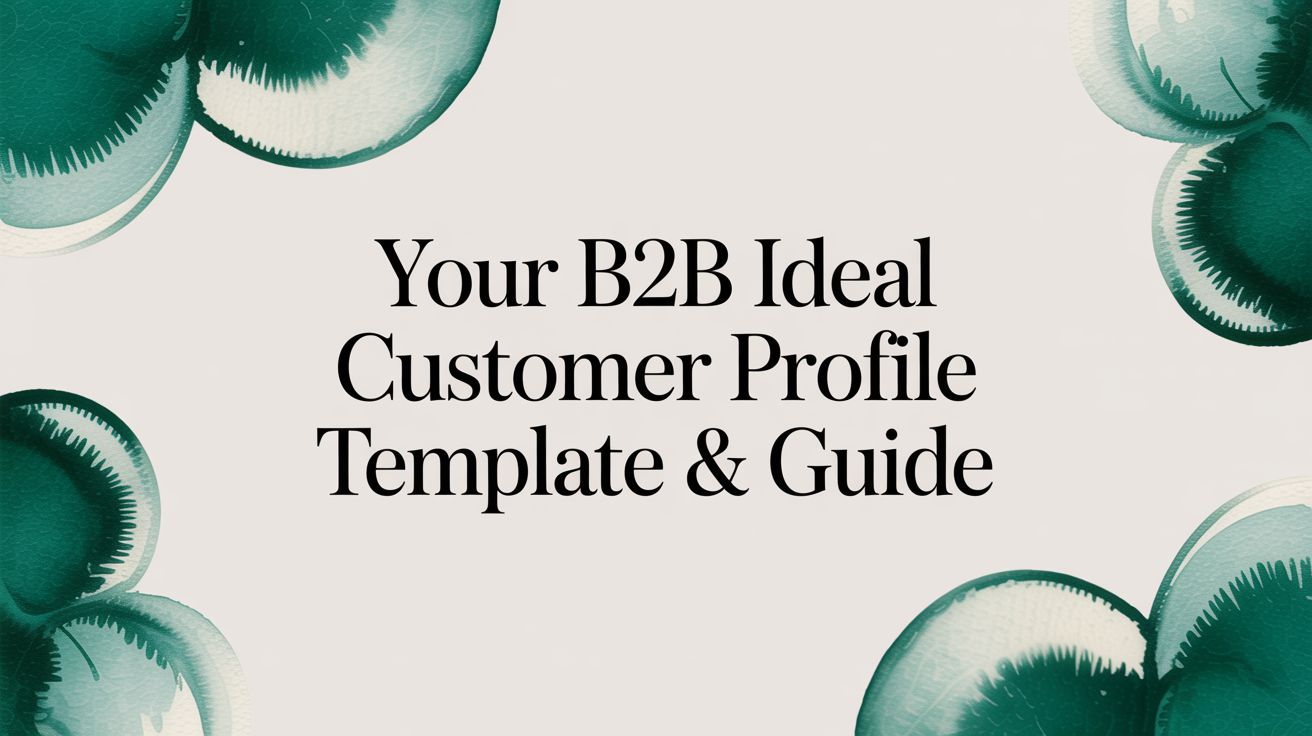Choosing a Demand Generation Agency for B2B Growth
October 13, 2025

A demand generation agency is more than just a lead factory; they're a strategic partner dedicated to creating and capturing long-term buyer interest for B2B companies. Their real job is to build a complete system that makes your ideal customers want to seek you out, drawing in high-intent buyers who are already warmed up to your solution.
Moving Beyond Leads To Build Your B2B Future
Imagine a world where your ideal customers don’t just stumble upon your B2B company—they actively seek you out, already convinced you understand their problems. This is the future a modern demand generation agency aims to build. It’s a profound shift away from the outdated game of simply collecting a list of names.
Think of this agency not as a vendor you hire for a specific task, but as the architect of your company’s growth engine. Their goal is to design the entire blueprint for attracting, engaging, and ultimately winning your most valuable customers. This isn’t about chasing short-term wins; it’s about building a predictable revenue machine that lasts.
Designing a System for Growth
A true demand generation agency doesn’t just run campaigns; they create an integrated system where every part works together to pull ideal customers closer. This system is typically built on a few key pillars:
- Compelling Educational Content: Think insightful articles, webinars, and reports that genuinely solve your audience's biggest business headaches.
- Targeted Channel Strategy: They figure out exactly where your ideal B2B buyers gather online and then work to dominate those channels.
- Memorable Brand Experiences: It’s all about building a brand that resonates and establishes trust long before a sales conversation ever begins.
This schematic shows how a well-designed growth engine guides ideal B2B customers through various touchpoints and into your company's ecosystem.

What this really highlights is that success isn't about a single tactic. It’s about creating a series of interconnected pathways that make the buyer's journey feel natural and intuitive. This strategic approach is crucial, and you can dive deeper into the nuts and bolts of mapping the customer journey in B2B to see how all these pieces fit together.
The core idea is to shift from interrupting potential buyers to becoming the destination they willingly travel to for answers and solutions.
Ultimately, this holistic approach creates a sustainable pipeline of high-intent prospects who aren't just "qualified" on paper—they're genuinely interested in what you have to offer. For B2B founders, this means finally moving away from the rollercoaster of inconsistent results and toward a future of predictable, scalable growth.
Demand Generation vs Lead Generation A Fundamental Shift
To truly appreciate what a modern demand generation agency brings to the table, it’s helpful to see how it stacks up against the old-school lead generation model. The table below breaks down the crucial differences, highlighting the strategic shift that B2B leaders need to grasp.
This isn't just a semantic difference; it's a fundamental change in mindset. While lead gen is about casting a wide net and hoping for the best, demand gen is about becoming a magnet for your ideal B2B customers, making the entire sales process smoother and more effective.
The Core Services That Drive Authentic Demand

So, what does a demand gen agency actually do? Forget a simple checklist of tasks. A great agency orchestrates a whole series of interconnected plays designed to build momentum and create a powerful pull toward your B2B solution.
It's less like ticking boxes and more like conducting a symphony, where every instrument—from content to targeted outreach—plays a vital part in the final performance. The goal isn't just to get a lead; it's to make your company the obvious, trusted choice in your market.
At the heart of it all is insightful, problem-solving content. A recent study found that a staggering 87% of B2B marketers see content as the main engine for demand generation. This isn't just about churning out blog posts; it's about systematically establishing your company as the go-to authority in your space.
Creating and Distributing High-Value Content
A skilled agency doesn't just write—they build a content engine. They start by getting inside the heads of your ideal B2B customers, identifying their most pressing business challenges, and then creating resources that offer genuine, actionable solutions.
This content can take a lot of different forms, each playing a specific role in guiding a buyer:
- In-depth Articles and Guides: These are the workhorses. They establish your expertise on a topic and are meticulously optimized to capture B2B buyers who are already searching for solutions.
- Webinars and Virtual Events: This is where you bring your expertise to life. These formats allow for direct engagement with your audience, positioning your team as accessible experts and building a real community around your brand.
- Original Research and Reports: This is how you become the source. By providing unique data and insights that no one else has, you create an asset that others will cite, massively amplifying your reach and credibility.
Of course, creating world-class content is only half the battle. A top-tier agency also excels at getting these assets in front of the right eyeballs, distributing them across the channels where your ideal buyers already spend their time.
Activating and Nurturing Target Accounts
Beyond creating broad-appeal content, a core function is precision targeting through Account-Based Marketing (ABM). This is where the agency identifies a shortlist of your highest-value future customers and crafts personalized campaigns that speak directly to their specific needs. It's a highly focused approach that makes sure your marketing dollars are spent where they'll have the biggest impact.
To manage all of this at scale, they bring in sophisticated marketing automation. This technology is what allows you to nurture relationships over time, delivering the right message at exactly the right moment without someone having to manually press "send." The strategic use of top lead generation tools is critical here, helping to attract and convert prospects effectively within these automated flows.
At its heart, an agency’s service is to build a system that makes you the obvious choice for your ideal B2B customer long before they ever think about making a purchase.
Ultimately, all these services—content, SEO, ABM, and automation—are woven together into a single, cohesive strategy. They work in concert to build a powerful, self-sustaining engine that attracts, engages, and prepares your ideal customers for a conversation with your sales team. Our complete guide on B2B demand generation tactics for growth offers a deeper dive into these proven strategies.
Measuring What Truly Matters for Growth

It’s easy to get hooked on the dopamine hit of rising website traffic or a spike in social media impressions. But those numbers don't pay salaries or keep the servers running.
A top-tier demand generation agency understands this better than anyone. They operate on a simple principle: if you can't tie marketing activity directly to revenue, it's just noise.
Think of it this way: vanity metrics are like the roar of the crowd at a football game. It feels great, but it doesn't change the score. Real business metrics are the points on the scoreboard—the only thing that actually determines if you win. An agency worth its salt lives and breathes by that scoreboard, not the applause.
They help you make the critical shift from counting online activity to tracking the outcomes that every founder and investor actually cares about. This laser focus ensures every dollar you spend is a calculated investment in predictable growth, not just a shot in the dark.
Moving Beyond Vanity Metrics
The first order of business is to get ruthless about what "success" really looks like. It’s not about how many people saw your ad; it’s about how many of the right B2B buyers took a meaningful step toward becoming a customer.
This means you have to prioritize metrics that signal genuine buying intent and pipeline momentum. These are the numbers that forge an unbreakable link between your agency’s work and your sales team’s success. Getting this part right is non-negotiable, and it’s a core part of understanding how to measure marketing effectiveness for sustainable growth.
The table below breaks down the key performance indicators that a serious demand generation program should be built around. These aren't just numbers on a dashboard; they are the vital signs of your growth engine.
Key B2B Demand Generation Performance Indicators
Each of these metrics tells a piece of the story, but together, they give you a complete picture of whether your marketing is truly driving the business forward or just spinning its wheels.
The goal isn't just to fill the funnel; it's to create a high-speed pipeline that consistently delivers revenue. Focusing on pipeline velocity is how you turn marketing activity into predictable cash flow.
Tying Marketing Efforts to Revenue
At the end of the day, it all comes down to the financial metrics. Any skilled demand generation agency will obsess over connecting their campaigns to the numbers that define your company's long-term health and valuation.
They zero in on the two questions that matter most: are we acquiring customers profitably, and are those customers valuable over the long haul?
This is where metrics like Customer Acquisition Cost (CAC) and Lifetime Value (LTV) become the stars of the show. A healthy B2B business needs the value of a customer to far outweigh the cost to acquire them. By relentlessly tracking and improving the LTV to CAC ratio, a great agency proves its worth not just as a marketing partner, but as a core driver of your company's growth engine.
How to Select the Right Agency Partner
Picking a demand generation agency is one of those make-or-break decisions for your B2B company. Let’s be real. The right partner becomes a true extension of your team, someone who architects growth alongside you. The wrong one? They can torch your budget and leave you with nothing but smoke.
You have to look past the slick sales pitch and use a solid framework to figure out who can actually deliver. This isn’t about hiring another vendor to check off tasks. It's about finding a strategic ally.
A great partner doesn't just execute. They challenge your assumptions, bring fresh insights to the table, and operate with a founder's mentality. They should be just as obsessed with your business outcomes as you are, making your success their own mission.
Look for Niche B2B Experience
Generalist agencies, the ones that do a little bit of everything for everyone, often stumble when it comes to the details of B2B marketing. Your ideal partner needs to have deep, provable experience in your specific niche. They have to speak your customers' language fluently and get the unique pain points and buying triggers that drive decisions in your industry.
This specialized knowledge is a massive accelerator. An agency that already knows your market doesn't waste your first three months on a learning curve. They hit the ground running, crafting strategies that resonate from day one because they’ve already solved similar problems for companies just like yours. Digging into how a specialized agency for B2B marketing works can give you a better sense of this advantage.
The goal is to find a partner who has already solved your biggest growth problems for a company just like yours. Their experience becomes your shortcut to predictable revenue.
Ask the Right Questions
The vetting process is your chance to dig deep and uncover an agency's true strategic muscle. Get past the surface-level stuff about their services. Your questions should be designed to reveal how they think, plan, and execute.
Here are a few essential questions to get you started:
- How will you measure success in the first 90 days? This cuts right to the chase. It shows if they understand the difference between short-term wins and long-term growth and makes sure you're both on the same page from the start.
- Describe a time a B2B campaign failed and what you learned. This is a test of transparency and accountability. You want a partner who can own their mistakes, learn from them, and adapt. Those are critical traits.
- How would you tailor a strategy for our Ideal Customer Profile? This forces them to move beyond generic templates and show you some specific, relevant thinking about your business.
- What will you need from my team to be successful? This question sets the stage for a real partnership by clarifying roles and responsibilities right out of the gate.
To make sure you're covering all your bases, it helps to have a full list of questions ready. While this guide on 10 Questions To Ask Before Hiring A PPC Management Agency is focused on PPC, the principles for vetting a strategic partner are universal and apply perfectly here.
Prioritize Strategic Capability and Transparency
Finally, any top-tier demand generation agency has to demonstrate sharp strategic thinking. They shouldn’t just throw a list of tactics at you. They should present a clear, logical plan that connects every proposed activity directly back to your core business objectives, whether that's increasing pipeline velocity or slashing your customer acquisition cost.
Just as important is a commitment to radical transparency. Look for an agency that provides clear, straightforward reporting on the metrics that actually matter. They should be eager to have honest conversations about what’s working, what isn’t, and how they plan to optimize for better results.
This open line of communication is the bedrock of a successful, long-term partnership built on trust and shared goals.
Budgeting for Predictable Revenue Growth
It’s easy to look at a demand generation budget as a line-item expense—a cost to be minimized. But that’s a surefire way to stall your growth. A better way to think about it is as an investment in the engine that builds predictable, long-term revenue for your B2B company. This isn’t about spending money; it’s about strategically allocating capital to create a clear, repeatable path to acquiring your most valuable customers.
When you bring on a skilled demand generation agency, you’re funding a system designed to accelerate your entire pipeline. Every dollar is put to work creating awareness, building trust, and shortening the sales cycle. This approach gives you the data-backed confidence needed to champion a larger marketing investment that connects directly to business outcomes.
Aligning Your Budget with Business Outcomes
So, what’s the right budget? It’s not a number you pull out of thin air or base on arbitrary percentages. A common mistake is to budget based on last year’s performance. Instead, you need to budget for the future you want to create. This means working backward from your revenue targets to figure out exactly what it’s going to take to hit those numbers.
This strategic alignment is a game-changer. It shifts the entire conversation from, "How much can we afford to spend?" to "What investment is required to achieve our growth objectives?" For a deeper look into structuring your financial plan, our guide on B2B marketing budget allocation breaks down the top tactics for maximizing your return.
An effective budget is a strategic document that funds a growth plan. It's not an expense line item to be minimized, but a direct investment in your company's future market share.
This shift in perspective is what separates high-growth B2B companies from the rest. It ensures every single marketing activity is accountable to pipeline and revenue, creating a culture of performance and predictability.
Benchmarks and Content Investment
It helps to know what others are doing. A recent Demand Generation Benchmark Survey revealed that 35% of B2B companies are increasing their demand gen budgets. What are they expecting in return? 28% of them are projecting revenue growth of 11-20% from these ramped-up marketing efforts.
But here’s the real opportunity: the survey found that only 29% of firms have fully integrated their brand and demand marketing. That’s a massive opening for companies that can get it right. You can explore the full findings to learn more about how B2B companies are tying strategy to revenue.
The survey also pointed to which content formats are really moving the needle. An impressive 57% of marketers favored case studies, which tells you everything you need to know about the value of trust-building stories that prove your solution works.
- Case Studies: These provide hard proof that your product delivers on its promises, building critical credibility with prospects who are close to making a decision.
- Webinars: A great way to position your team as thought leaders and create direct, meaningful engagement with your target audience.
- Original Research: This establishes your company as an authority in your space and generates priceless backlinks and media mentions.
Investing in high-quality content like this isn't just about filling up a blog. It’s about creating strategic assets that build trust, shrink sales cycles, and empower your internal champions to make a strong case for your solution. A smart budget allocates resources to these high-impact formats to drive real business momentum.
A Few Common Questions
Deciding to bring on a demand generation agency is a big move, and it's natural to have questions. It’s a serious investment for any B2B founder, so you need to go in with your eyes wide open. This is where we tackle the most common things that come up, giving you the direct answers you need to choose the right path for your company.
Think of this as the final briefing before you commit. Getting these details right can be the difference between a partnership that just brings in a few leads and one that builds a predictable revenue engine.
How Long Until We See Real Results?
This is probably the most common question I get, and the answer has two parts. You'll likely see some early signs of life within the first one to two months—things like more website traffic, better keyword rankings, or more people engaging with you on social media.
But the results that actually matter to the business? That takes a bit longer. A steady stream of marketing-qualified leads (MQLs) and real, measurable growth in your sales pipeline usually starts to show up around the four to six-month mark. Demand generation isn’t a light switch you can just flip on. It's more like a heavy flywheel. It takes time to get it spinning, but once it has momentum from solid content and growing brand authority, it becomes a powerful, self-sustaining force. Any good agency will be upfront about this timeline and give you a clear roadmap of both the quick wins and the long-term revenue goals.
How Is a Demand Generation Agency Different From a Regular Digital Marketing Agency?
A typical digital marketing agency is often a team of specialists you hire to execute specific tasks. They might run a Google Ads campaign for you or manage your LinkedIn page. Think of them as contractors you bring in to do a specific job.
A demand generation agency, on the other hand, operates at a much higher, more strategic level. They're less like a contractor and more like the architect of your entire growth plan.
Their job is to look at the whole B2B buyer's journey from start to finish. They don't just care about getting a click; they build an integrated system that creates awareness, nurtures prospects with valuable content, and hands over sales-ready opportunities to your team.
The real difference is the goal. A digital marketing agency might aim to increase your website traffic by 20%. A demand generation agency aims to increase your sales pipeline by 20%, and they see traffic as just one of many tools to get there.
Their ultimate goal is to build a cohesive engine designed specifically to create, capture, and convert demand for a complex B2B solution like yours. Every single marketing activity has to tie back to a revenue outcome.
What Should We Have Ready Before We Talk to an Agency?
To get the most out of that first conversation, it really helps to do a little homework beforehand. The clearer you are on your end, a potential partner can figure out if it's a good fit and start mapping out a strategy that will actually work much faster.
Here’s a quick checklist of what to prepare:
- A Clear Ideal Customer Profile (ICP): Who, exactly, are you selling to? What are their biggest business headaches, and where do they go online to find solutions?
- Defined Business Goals: Be specific. Instead of "we want more leads," try something like, "we need to increase our qualified pipeline by 30% in the next six months."
- A Realistic Budget: You don't need an exact number down to the dollar, but you should have a solid idea of what you're prepared to invest to hit your growth targets.
- Access to Your Current Data: Any existing data you have on marketing and sales performance is gold. It gives an agency a real starting point to build from.
Can a Small B2B Company Really Afford an Agency?
Absolutely. Many agencies have flexible ways of working that can fit different budgets, from one-off projects to ongoing monthly retainers. The trick for an early-stage B2B company is finding a partner who gets the unique grind of scaling a business from the ground up.
The biggest mental shift is to stop thinking of it as an "expense" and start seeing it as a strategic investment. The right partnership should deliver a strong, measurable return by getting you to predictable revenue faster. In many cases, it's a much more efficient and cost-effective route than the long, expensive, and often frustrating process of trying to hire a full in-house marketing team from scratch.
Ready to build a B2B marketing engine that drives real revenue? At Big Moves Marketing, I partner with B2B SaaS and AI startups to craft the positioning, sales tools, and launch strategies that win deals and secure market leadership. Let's discuss how we can build your growth engine together.
%20-%20Alternate.svg)


%20-%20white.svg)